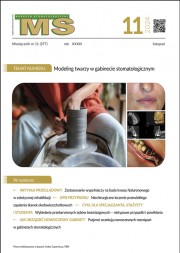Dostęp do tego artykułu jest płatny.
Zapraszamy do zakupu!
Po dokonaniu zakupu artykuł w postaci pliku PDF prześlemy bezpośrednio pod twój adres e-mail.
Technology to Control Excessive Occlusal Contact Force: Enhancing Implant Restoration Longevity
Christopher J. Stevens, DDS
DENTALCETODAY.COM (January 2017, pp. 112117)
Copyright © Biodent Jankowiak Sp.j.
Streszczenie
Celem artykułu jest omówienie wpływu nadmiernych kontaktów okluzyjnych na stan kości wyrostka zębodołowego wokół implantu oraz przedstawienie aktualnych koncepcji okluzji rekonstrukcji protetycznych opartych na wszczepach. Zaprezentowane zostaną również trzy przypadki kliniczne, w terapii których zastosowano dostępne aktualnie metody kontroli czasu trwania przypadkowych obciążeń i siły, z jaką działają one na powierzchnię żującą koron protetycznych.
Hasła indeksowe: T-Scan, implant, okluzja
PIŚMIENNICTWO
1. Koldsland O.C., Scheie A.A., Aass A.M.: Prevalence of implant loss and the influence of associated factors. J. Periodontol. 2009, 80, 1069-1075.
2. Kohavi D.: Complications in the tissue integrated prostheses components: clinical and mechanical evaluation. J. Oral Rehabil., 1993, 20, 413-422.
3. Isidor F.: Histological evaluation of peri-implant bone at implants subjected to occlusal overload or plaque accumulation. Clin. Oral Implants Res., 1997, 8, 1-9.
4. Oh T.J. i wsp.: The causes of early implant bone loss: myth or science? J. Periodontol., 2002, 73, 322-333.
5. Esposito M.: Biological factors contributing to failures of osseointegrated oral implants. (II). Etiopathogenesis. Eur. J. Oral Sci., 1998, 106, 721-764.
6. Heydenrijk K. i wsp.: Microbiota around root-form endosseous implants: a review of the literature. Int. J. Oral Maxillofac. Implants, 2002, 17, 829-838.
7. Rosenberg E.S., Torosian J.P., Stots J.: Microbial differences in 2 clinically distinct types of failures of osseointegrated implants. Clin. Oral Implants Res., 1991, 2, 135-144.
8. van Steenberghe D. i wsp.: Influence of inflammatory reactions vs. occlusal loading on peri-implant marginal bone level. Adv. Dent. Res., 1999, 13, 130-135.
9. Jansson H. i wsp.: Clinical consequences of IL-1 genotype on early implant failures in patients under periodontal maintenance. Clin. Implant Dent. Relat. Res., 2005, 7, 51-59.
10. Misch C.E.: Contemporary Implant Dentistry. Mosby, St. Louis, MO 1993.
11. Saadoun A.P., LeGall M., Kricheck M.: Microbial infections and occlusal overload are the two primary causes of failure in osseointegrated implants. Pract. Periodontics Aesthet. Dent., 1993, 5, 11-20.
12. Quirynen M., Naert I., van Steenberghe D.: Fixture design and overload influence marginal bone loss and fixture success in the Brånemark system. Clin. Oral Implants Res., 1992, 3, 104-111.
13. Leung K.C. i wsp.: Peri-implant bone loss: management of a patient. Int. J. Oral Maxillofac. Implants, 2001, 16, 273-277.
14. Stevens C.J.: Computerized occlusal implant management with the T-Scan II System: a case report. Dent. Today, 2006, 25, 2, 88-91.
15. Hämmerle C.H. i wsp.: Threshold of tactile sensitivity perceived with dental endosseous implants and natural teeth. Clin. Oral Implants Res., 1995, 6, 2, 83-90.
16. Parfitt G.J.: Measurement of the physiological mobility of individual teeth in an axial direction. J. Dent. Res., 1960, 39, 608-618.
17. Sekine H. i wsp.: Mobility characteristics and tactile sensitivity of osseointegrated fixture-supporting systems. In: van Steenberghe D. (ed.): Tissue Integration in Oral Maxillofacial Reconstruction. Elsevier, Amsterdam, Netherlands 1986, 306-332.
18. Misch C.E., Bides M.W.: Implant-protected occlusion. Int. J. Dent. Symp., 1994, 2, 32-37.
19. Kim Y. i wsp.: Occlusal considerations in implant therapy: clinical guidelines with biomechanical rationale. Clin. Oral Implants Res., 2005, 16, 26-35.
20. Kerstein R.B.: Nonsimultaneous tooth contact in combined implant and natural tooth occlusal schemes. Pract. Proced. Aesthet. Dent., 2001, 13, 751-755.
21. Kerstein R.B.: Computerized occlusal management of a fixed/detachable implant prosthesis. Pract. Periodontics Aesthet. Dent., 1999, 11, 1093-1102.
22. Kirvescari P.: Assessment of occlusal stability by measuring contact time and centric slide. J. Oral Rehabil., 1999, 26, 763-766.
23. Lyons M.F. i wsp.: An evaluation of the T-Scan computerised occlusal analysis system. Int. J. Prosthodont., 1992, 5, 166-172.
24. Mizui M. i wsp.: Quantitative analysis of occlusal balance in intercuspal position using T-Scan system. Int. J. Prosthodont., 1994, 7, 62-71.
25. Dario L.J.: How occlusal forces change in implant patients: a clinical research report. J. Am. Dent. Assoc., 1995, 126, 1130-1133.
26. González Sequeros O., Garrido García V.C., García Cartagena A.: Study of occlusal contact variability within individuals in a position of maximum intercuspation using the T-SCAN system. J. Oral Rehabil., 1997, 24, 287-290.
27. Garcia Cartagena A., Gonzalez Sequeros O., Garrido Garcia V.C.: Analysis of two methods for occlusal contact registration with the T-Scan system. J. Oral Rehabil., 1997, 24, 426-432.
28. Garrido García V.C., García Cartagena A., González Sequeros O.: Evaluation of occlusal contacts in maximum intercuspation using the T-Scan system. J. Oral Rehabil., 1997, 24, 899-903.
29. Misch C.E. i wsp.: A positive correlation between occlusal trauma and peri-implant bone loss: literature support. Implant Dent., 2005, 14, 108-116.
30. Chapman R.J.: Principles of occlusion for implant prostheses: guidelines for position, timing, and force of occlusal contacts. Quintessence Int., 1989, 20, 473-480.














